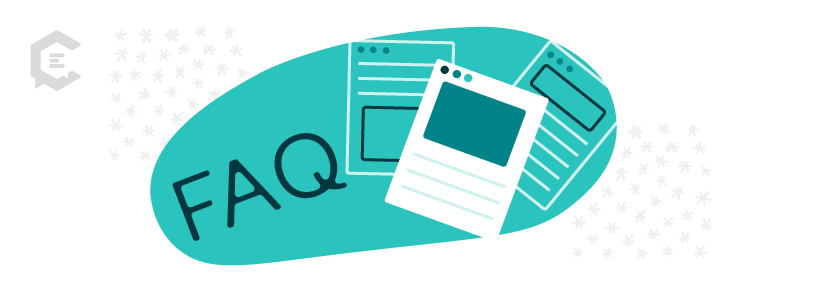An FAQ blog post is a smart way to turn your target audience’s questions into optimized content for your blog.
Maybe FAQs have gotten a bad rap: They get thrown at the end of an article like an addendum — an underappreciated afterthought, a seemingly unimportant footnote. But you know what?
A lot of people make a beeline straight for the frequently asked questions (FAQs) section moments after they reach your site. Why? There’s a good chance this section either directly or indirectly addresses one of their burning questions about your product, service, or topic.
This is why FAQs make excellent blog content, especially during the content ideation process. More specifically, they can form the foundation of a cluster content strategy that keeps readers on your site, addresses their concerns and queries, and boosts your SEO.
Here’s how you can turn FAQs into compelling blog content and how they can play a primary role in topic clustering.
What exactly is a blog intended to be used for?
Before we get into how to create an FAQ blog post, let’s look at the role of blogs overall.
A blog has two jobs:
- Educate and intrigue your audience, motivating them to stay on your page and engage with your products and services
- Establish your company as an expert in your field, which earns the trust and confidence of prospects, inspiring them to make a purchase
Educating and engaging your audience
The first objective, educating your audience and keeping them engaged, can also make them spend more time on your page, especially if you address customer pain points. This can boost your search results. The longer people spend on your page, the more likely Google is to view it as a trustworthy resource its algorithms can recommend to others.
Establishing your company as an expert
The second objective, establishing your company as an expert, translates into increased revenue as you earn customer trust. For example, if you go to the dentist and they take a quick look in your mouth and say, “Hey, you need a $7,000 root canal,” you may be hesitant to whip out your wallet.
On the other hand, if they take the time to explain where the damage is, how and why it’s causing you pain, the role of nociceptors in oral discomfort, and how the exposed nerves in your tooth are resulting in mouth pain, you may be more likely to consider having the procedure done — even though seven stacks is a whole different kind of pain, ouch!
In a similar way, it’s wise to use FAQs to provide visitors with a full breakdown of the details of a product or service, as well as topics related to it. This shows them you have the kind of deep knowledge they need in a provider.
What is a topic cluster, and how does it relate to an FAQ blog post?
A topic cluster is a way of organizing ideas around a central topic. For example, a company selling business intelligence (BI) software may have a topic cluster with “business intelligence” at its core.
Then, the following subtopics could branch off from it:
- What is the value-add of BI services?
- What are the best software tools for providing business intelligence?
- What’s the difference between a business advisor and a business intelligence provider?
- Can you DIY business intelligence?
By structuring your topic clusters in this way, you allow your FAQs to organically keep them focused on what’s top-of-mind for your customers.
What is the primary purpose of a topic cluster content strategy?
The primary purpose of a topic cluster strategy is to keep readers engaged with your content by giving them a little solar system that revolves around something they’re interested in. In most cases, the focal point is a problem your solution solves.
Topics tangential to that central problem revolve around it, like planets, inextricably connected to both the primary issue and each other.
Why are topic clusters important in content marketing? The purpose of organizing these subjects into a cluster is to give your readers a range of relevant resources and destinations that provide answers to their questions. They also position you as an authority in that specific area.
For example, suppose you have a cybersecurity company, and you’re trying to create content for your site. You can break up cybersecurity into several different smaller topics and create clusters around each one.
This gives your customers focused content related to each cybersecurity topic, and as a result, two things happen:
- Your customers view your site as a powerful, free educational resource they can trust.
- They view you as a genuine expert in your field, someone they can trust to provide a comprehensive cybersecurity solution.
First, you have to choose the central “sun” of one of your topic solar systems. In this case, it could be “firewalls.” Then you can proceed to come up with subtopics that function as the “planets” of the cluster.
Now, you could randomly throw out phrases such as “firewall technology,” “data traffic filtering,” “website access control,” or “VPNs.” That might work. But there’s a better, easier, and faster way to keep it simple and meet your customers where they are: using FAQs for cluster content ideas.
How can FAQs be used to create topic clusters?
In the context of content clusters, you can use FAQs to brainstorm topic ideas that are not only relevant to your central topic but also genuinely helpful to your target market.
They naturally lend themselves to conversational search queries, paving the way for customer success stories.
Returning to the “firewall” topic cluster example, it’s easy to see how FAQs give you an efficient topic-creation shortcut. Here’s how it works: You take a few minutes to brainstorm the kinds of questions your customers may ask about firewalls.
Depending on your target market, you may want to categorize them according to questions aimed at “experienced” or “newbie” — or less experienced — prospects.
For example, for less-experienced readers, your FAQs may include:
- What is a firewall?
- How does a firewall work?
- What kinds of threats can firewalls prevent?
- What’s the difference between a traditional firewall and a next-generation firewall?
- What are some examples of firewalls stopping threats?
For more experienced readers, your FAQs could include:
- What is packet filtering?
- What does a firewall do with header information?
- How can you use firewalls in a network segmentation strategy?
- What’s the difference between software and hardware firewalls?
- Which kinds of firewalls can best protect my cloud infrastructure?
Within a few minutes, you have 10 interesting topics, all based on things your target customers are wondering. But that may leave you wondering whether an FAQ even works at the start of a blog post.
Can I start a blog post with a question?
Yes, you can. Granted, each of the above queries could live in an FAQ section, and that would be OK. You pose the question and then answer it in one to three sentences. But, in most cases, the answer, no matter how accurate or well-worded, will leave other critical questions unanswered.
By creating an entire FAQ blog post out of each question, you ensure your reader has a crystal-clear understanding of the topic. More importantly, because your blog answered their questions, they’re better poised to entrust you with their business. Another similar strategy is to use FAQs to make pillar pages.
The Role of FAQs in Creating Pillar Pages
While you could stop using FAQs as brainstorming machines, it may be best for your readers to take it a step further and use them to craft pillar pages. A pillar page is one that covers a specific topic in-depth and typically involves long-form content.
In other words, when readers go to a pillar page, they get a well-rounded, holistic view of a topic or practical advice. They may also contain step-by-step instructions or tips and tricks — anything that addresses a full range of readers’ needs. Because FAQs help you delve into the nuances of a topic, they can be powerful tools when creating your pillar content strategy.
What is the Purpose of a Pillar Page?
The purpose of a pillar page is to give prospective customers, as well as other webmasters, a one-stop shop filled with valuable information. Your target market goes to your pillar page to have a range of questions answered about a topic, and webmasters may choose to hyperlink to it because it provides reliable, authoritative, and accurate information.
FAQs can play a dual role in relation to pillar pages:
- They can form the subheadings on the pillar page itself.
- They can be used as blog topics the page links to, providing visitors with additional, related information.
Here’s an example of how to create a pillar page using FAQs and everyone’s favorite beverage:
How to Turn FAQs into Pillar Pages — Using Coffee
Suppose you run a coffee house called Java the Hut, and you want a pillar page that customers can depend on for product advice and general info about all things coffee. Here’s how the content map could play out to optimize the customer service and solutions your pillar page provides:
Title of pillar page: The Basics of Coffee
Subheadings (generated using FAQs):
- What is coffee?
- How does coffee go from beans to brew?
- Where is the best coffee grown?
- What makes an awesome cup of coffee?
- What are the health benefits of coffee?
- Is too much coffee a bad thing?
- What gives each roast its unique taste?
- What makes Java the Hut’s coffee so unique?
The last heading, “What makes Java the Hut’s coffee so unique?” may be a good place to implement calls-to-action, encouraging thirsty customers to start sippin’ your brew.
Maximize the Impact of FAQ Blog Posts with ClearVoice
ClearVoice has experienced writers and content strategists ready to help you use FAQs to create blogs and pillar pages that drive conversions. ClearVoice’s professionals can make your writing snackable and compelling while taking your SEO results to the next level. Get started with ClearVoice today!








